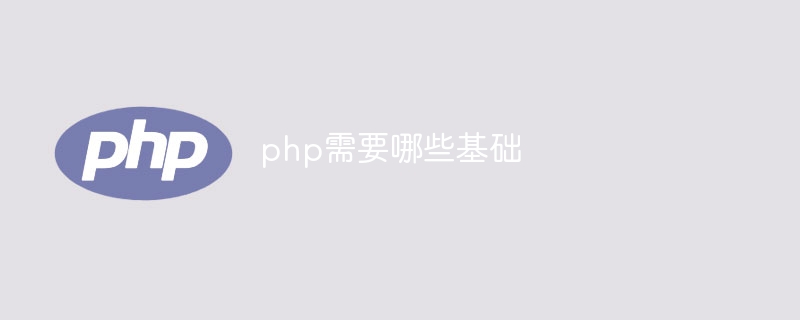Home >Backend Development >PHP Problem >What basics do php need?
What basics do php need?
- zbtOriginal
- 2023-08-01 16:27:431170browse
php requires PHP syntax, variables and data types, operators, flow control, functions and arrays. 1. The syntax of PHP is a weakly typed language; 2. Variables and data types. Variables are used to store data. There is no need to specify the data type when declaring variables; 3. Operators. In PHP, we can use various operations Symbols are used to perform mathematical operations, logical operations, comparison operations, etc.; 4. Process control, used to control the execution flow of the program; 5. Functions, used to implement specific functions; 6. Arrays, which can be used to store and operate multiple values.

The operating environment of this tutorial: windows10 system, php8.1.3 version, DELL G3 computer.
PHP is a scripting language widely used in server-side development, which can be used to create dynamic web pages and web applications. Mastering the basic knowledge of PHP is very important for becoming a qualified web developer. This article will introduce the basic knowledge of PHP, including syntax, variables, data types, operators, flow control, functions, arrays, etc.
1. PHP syntax
The syntax of PHP is similar to that of most programming languages. It is a weakly typed language. The following are some basic syntax points of PHP:
1. PHP code must be included in the `` tag, and PHP code can be directly embedded in the HTML file.
2. PHP statements end with a semicolon (;).
3. PHP is not case-sensitive, but it is recommended to use lowercase letters to write code to improve the readability of the code.
2. Variables and data types
In PHP, variables are used to store data. Unlike most programming languages, there is no need to specify a data type when declaring a variable. The following are commonly used data types in PHP:
1. String: A sequence of characters enclosed in quotation marks.
2. Integer: A value without a decimal part.
3. Floating point number (float): a numerical value with a decimal part.
4. Boolean: A value indicating true or false, which can be true or false.
5. Array: A container used to store multiple values.
3. Operators
In PHP, we can use various operators to perform mathematical operations, logical operations, comparison operations, etc. The following are common operators in PHP:
1. Arithmetic operators: used to perform basic mathematical calculations, such as addition ` `, subtraction `-`, multiplication `*` and division `/`, etc.
2. Logical operators: used to combine and compare Boolean values, such as and `&&`, or `||` and not `!`, etc.
3. Comparison operators: used to compare the relationship between two values, such as equal to `==`, not equal to `!=`, greater than `>` and less than `<`, etc.
4. Process control
Process control is an important concept in programming, used to control the execution flow of the program. In PHP, we can use conditional statements and loop statements to achieve flow control.
1. Conditional statement: used to execute different code blocks based on conditions. PHP provides if statements, if-else statements, switch statements, etc.
2. Loop statement: used to repeatedly execute a block of code. PHP provides for loop, while loop and foreach loop, etc.
5. Function
A function is a reusable block of code used to implement a specific function. There are many built-in functions in PHP, and you can also customize functions. The following are some key points of functions in PHP:
1. Built-in functions: PHP provides many built-in functions, such as string processing functions, date processing functions, and file processing functions.
2. Custom function: We can use the `function` keyword to define our own function. Functions can accept parameters and return values.
6. Array
An array is an ordered and accessible collection of data. In PHP, arrays are very important as they can be used to store and manipulate multiple values. The following are some key points of arrays in PHP:
1. Array type: PHP has two array types, namely index array and associative array.
2. Index array: an array with numbers as key names, and the key names start from 0.
3. Associative array: An array with strings as key names. The key names and values are related using arrow symbols (=>).
Summary:
Mastering the basics of PHP is essential to becoming a qualified web developer. This article introduces the basic knowledge of PHP syntax, variables and data types, operators, flow control, functions, and arrays. I hope it can help readers who want to learn PHP so that they can get started quickly and learn PHP programming in depth. .
The above is the detailed content of What basics do php need?. For more information, please follow other related articles on the PHP Chinese website!

